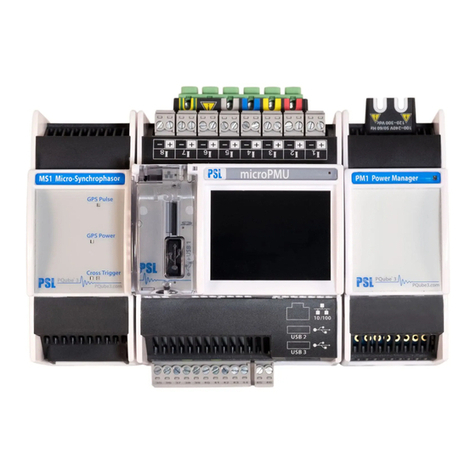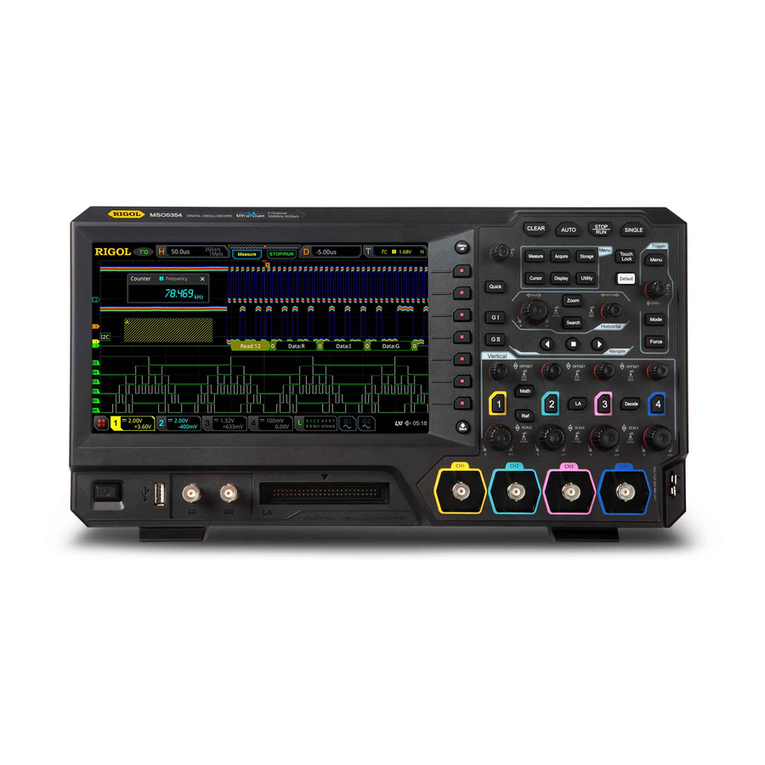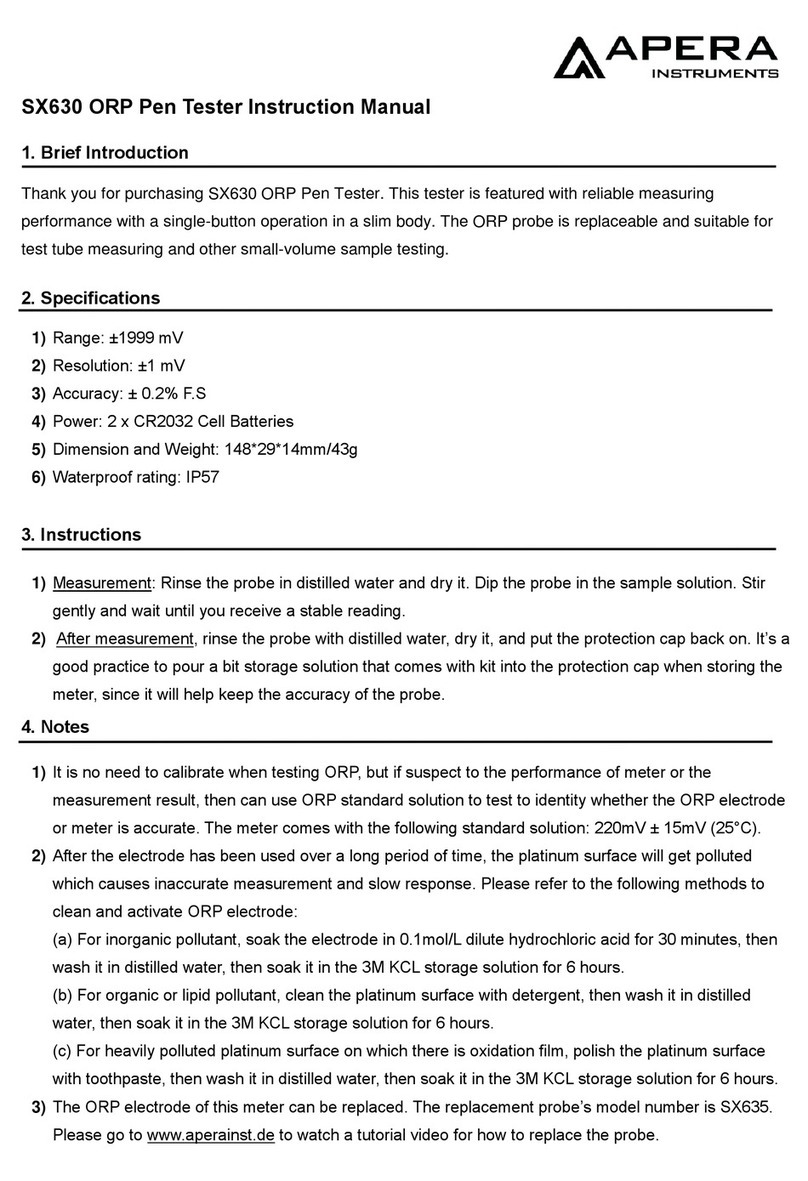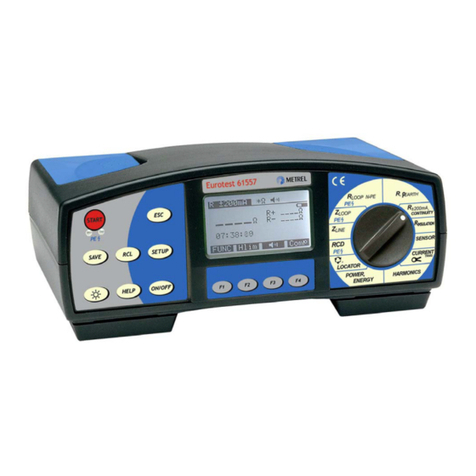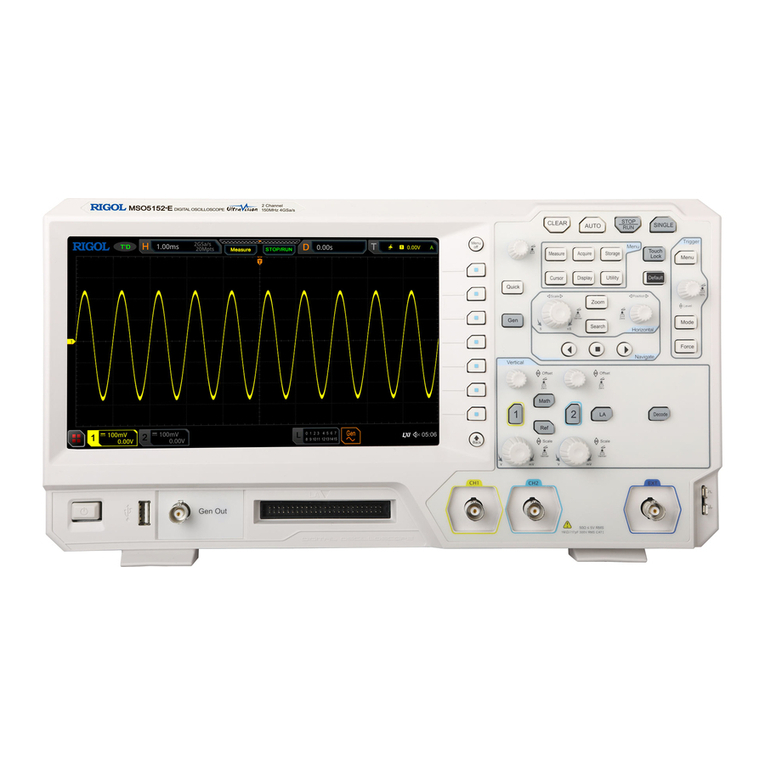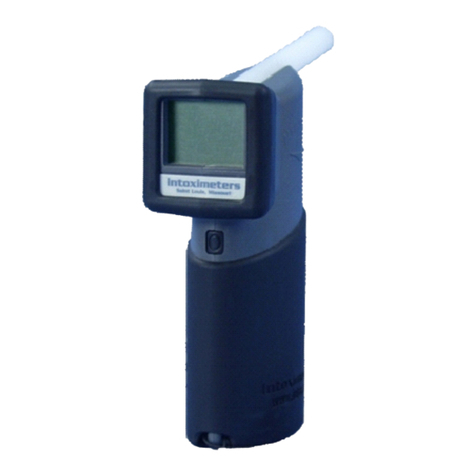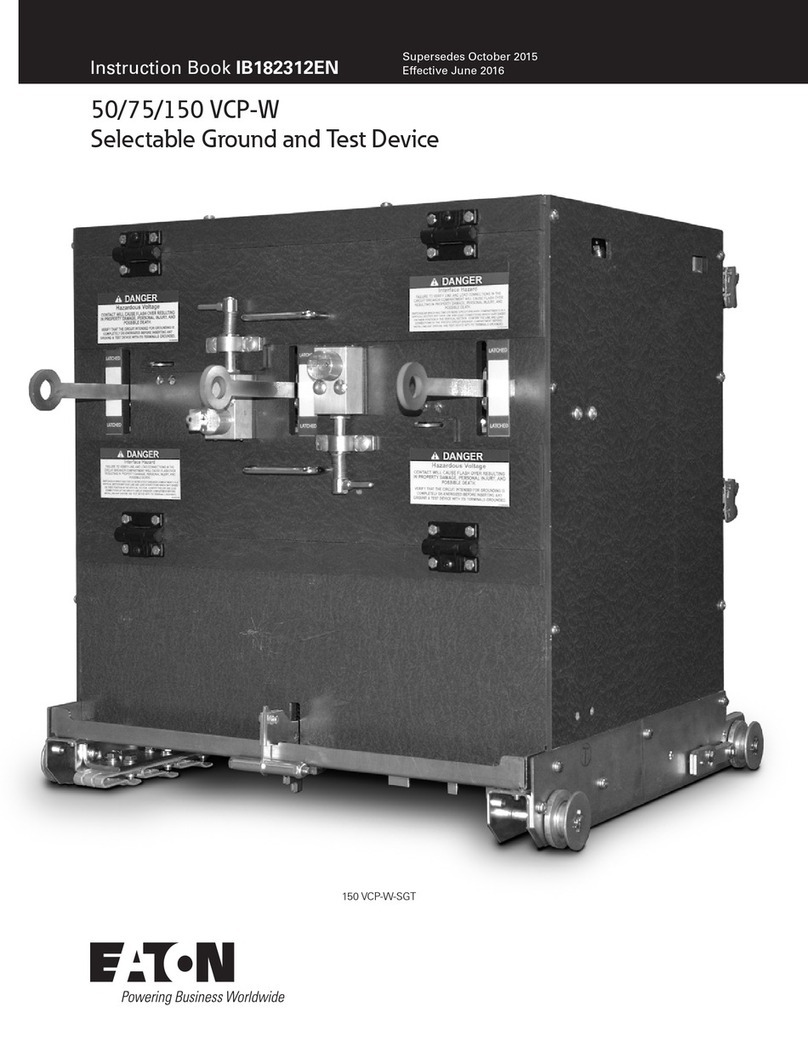PSL IPC-480V-200A User manual

page 1
Industrial Power Corruptor Manual Rev 1.00
PSLPSL
PSLPSL
PSL
Power Standards Lab
1201 Marina Village Parkway #101
Alameda, California 94501 U.S.A.
TEL ++1-510-522-4400
FAX ++1-510-522-4455
www.PowerStandards.com
IPC-480V-200A
IPC-480V-100A
IPC-480V-50A
IPC-240V-25A
Manual Revision 1.00
User’s Manual
Industrial Power Corruptor
R
absolute-emc.com
Phone:703-774-7505
Sales Partner:

page 2
Industrial Power Corruptor Manual Rev 1.00
WARNING: Death, serious injury, or fire hazard could result
from improper connection or operation of this instrument.
Carefully read and understand manual before connecting this
instrument.
AVERTISSEMENT: Si l'instrument est mal connecté, la mort,
des blessures graves, ou un danger d'incendie peuvent s'en
suivre. Lisez attentivement le manuel avant de connecter
l'instrument.
WARNUNG: Der falsche Anschluß dieses Gerätes kann Tod,
schwere Verletzungen oder Feuer verursachen. Bevor Sie
dieses Instrument anschließen, müssen Sie die Anleitung lesen
und verstanden haben.
ADVERTENCIA: Una conexión incorrecta de este instrumento
puede producir la muerte, lesiones graves y riesgo de incendio.
Lea y entienda el manual antes de conectar.
© 2005 Power Standards Lab. All rights reserved. No parts of this document may be copied, reproduced, or translated to
another language without the prior written consent of Power Standards Laboratory. “Industrial Power Corruptor” is a regis-
tered trademark of Power Standards Lab. “Windows” is a registered trademark of Microsoft.
The information contained in this document is subject to change without notice.
PSL MAKES NO WARRANTY OF ANY KIND WITH REGARD TO THIS MATERIAL, INCLUDING, BUT NOT
LIMITED TO, THE IMPLIED WARRANTIES OF MERCHANTABILITY AND FITNESS FOR A PARTICULAR
USE.
PSL shall not be liable for errors contained herein or for incidental or consequential damages in connection with the
furnishing, performance, or use of this material.
Printed in the United States of America.
First Printing: June 2003
absolute-emc.com
Phone:703-774-7505

page 3
Industrial Power Corruptor Manual Rev 1.00
Symbol Meaning
Caution. Risk of electric shock.
Caution. Refer to this manual.
Fuse. Replace only with indicated rating
and type.
Alternating current
Protective conductor terminal (earth)
Heavy. Risk of injury. Do not attempt to lift
by yourself.
Heavy. Use cart to transport.
Heavy. Lift with a partner.
SYMBOL TABLE
absolute-emc.com
Phone:703-774-7505

page 4
Industrial Power Corruptor Manual Rev 1.00
Table of Contents
1. Overview .......................................................................................................................................................................... 6
1.1 What is an Industrial Power Corruptor? ................................................................................................................. 6
1.2 What is a voltage sag? ............................................................................................................................................ 6
1.3 What is a voltage swell? ......................................................................................................................................... 7
1.4 Why generate sags and swells? ............................................................................................................................. 7
1.5 Why use a multi-channel data acquisition system? ............................................................................................... 7
1.6 Useful technical features of your IPC ..................................................................................................................... 7
1.7 Safety features of your IPC ..................................................................................................................................... 8
2. Testing ............................................................................................................................................................................. 9
2.1 Testing equipment with your Industrial Power Corruptor ........................................................................................ 9
2.2 Pre-test preparation ................................................................................................................................................. 9
2.2.1 Preparing the equipment to be tested ................................................................................................... 9
2.2.2 Safety ..................................................................................................................................................... 9
2.2.3 Unpacking your Industrial Power Corruptor ......................................................................................... 11
2.2.4 Connecting instrument power ............................................................................................................... 11
2.2.5 Connecting to your computer ............................................................................................................... 11
2.2.6 Connecting test power ......................................................................................................................... 12
2.2.6.1 Single-phase power connections ....................................................................................... 13
2.2.6.2 Three-phase delta power connections ............................................................................... 15
2.2.6.2 Three-Phase wye (star) power connections ....................................................................... 17
2.3 Types of testing ..................................................................................................................................................... 19
2.3.1 Choosing the type of test ..................................................................................................................... 19
2.3.2 International standards - a brief introduction ...................................................................................... 19
2.3.3 Voltage sag (dip) / swell immunity testing ........................................................................................... 19
2.3.4 Inrush current testing ........................................................................................................................... 19
2.3.5 Power consumption and harmonic testing .......................................................................................... 20
2.4 Reporting your results ............................................................................................................................. 20
3. Technical Description of your Industrial Power Corruptor ...................................................................................... 21
3.1 General description ............................................................................................................................................... 21
3.1.1 Theory of Operation ............................................................................................................................. 21
3.1.2 Major modules ..................................................................................................................................... 22
3.2 Front panel features .............................................................................................................................................. 24
3.2.1 Instrument power switch ...................................................................................................................... 24
3.2.2 PC port ................................................................................................................................................. 24
3.2.3 Circuit breaker control ......................................................................................................................... 24
3.2.4 Sag / Swell - Impulse switch ................................................................................................................ 25
3.2.5 Amplitude dial / display ........................................................................................................................ 25
3.2.6 Duration dial / display .......................................................................................................................... 25
3.2.7 Angle dial / display ............................................................................................................................... 25
3.2.8 Power Standard dial / display .............................................................................................................. 25
3.2.9 Step dial / display ................................................................................................................................. 26
3.2.10 Test Margin button ............................................................................................................................. 26
3.2.11 Phase dial / display ............................................................................................................................ 26
3.2.12 Arm and Fire switches - single sequence .......................................................................................... 26
3.2.13 Test Phases dial / display .................................................................................................................. 27
3.2.14 Arm / Stop and Fire switches - Auto sequence .................................................................................. 27
3.2.15 Meters ................................................................................................................................................ 27
3.2.16 High Voltage Input Channels ............................................................................................................. 28
3.2.17 Low Voltage Input Channels .............................................................................................................. 28
3.3 Rear panel connections ......................................................................................................................................... 29
3.3.1 Instrument power ................................................................................................................................. 29
3.3.2 Source and load connections .............................................................................................................. 29
3.3.3 Main circuit breaker ............................................................................................................................. 29
3.3.4 Triggers in/out BNC connectors (panic, arm, and sag) ....................................................................... 30
absolute-emc.com
Phone:703-774-7505

page 5
Industrial Power Corruptor Manual Rev 1.00
3.3.5 RJ-45 rear panel communications ports ............................................................................................. 30
3.3.6 Analog outputs ..................................................................................................................................... 30
3.3.7 Motor drive for circuit breaker (optional) ............................................................................................. 31
3.3.7 Impulse generator connectors (optional) ............................................................................................. 31
3.5 Software ................................................................................................................................................................ 32
3.5.1 Brief description ................................................................................................................................... 32
3.5.2 System Requirements .......................................................................................................................... 32
3.5.3 Installation ............................................................................................................................................ 34
3.5.4 Planning your test ................................................................................................................................ 35
3.5.4.1 Starting the IPC software ................................................................................................... 35
3.5.4.2 If you can't connect ............................................................................................................ 35
3.5.4.3 Setting up your testing session .......................................................................................... 36
3.5.5 On-screen meter .................................................................................................................................. 37
3.5.6 Triggering, selecting channels, and downloading ............................................................................... 38
3.5.7 Power flow analysis option .................................................................................................................. 40
3.5.7.1 Power flow meters .............................................................................................................. 41
3.5.7.2 Oscilloscope / spectrum analyzer ...................................................................................... 43
3.5.7.4 Vector scope ...................................................................................................................... 45
3.5.7.5 Power flow recorder ............................................................................................................ 46
3.5.8 ChannelScope II ................................................................................................................................. 47
3.5.9 FlowScope ........................................................................................................................................... 50
Appendix A - Status messages ....................................................................................................................................... 51
Appendix B - Specifications - general ............................................................................................................................ 54
Appendix C - Specifications - Maximum allowable current ........................................................................................ 56
Appendix D - Theory of Operation .................................................................................................................................. 58
absolute-emc.com
Phone:703-774-7505

page 6
Industrial Power Corruptor Manual Rev 1.00
1. Overview
1.1 What is an Industrial Power Corruptor?
An Industrial Power Corruptor produces bad quality electric
power, reliably and repeatedly.
Power from a clean source, such as your electric company, passes
through your IPC. Your IPC then adds disturbances - sags, swells,
interruptions, etc. - that reproduce disturbances that occur in the
real world. You use this disturbed power to test your equipment, to
verify that your equipment is rugged enough to tolerate power
disturbances.
Because all power for your equipment passes through your IPC,
you can use its optional Power Flow Analysis package to measure
and record all of your electric power parameters, including inrush
current, kWh, power factor, etc.
Your IPC includes many tools that make it easier to diagnose
power disturbance problems, including a 31-channel digital
oscilloscope, many pre-connected meters, and a waveform display
program that zooms, converts to true-RMS, and has graphs that you
can copy and paste into reports.
The optional Power Flow Analysis package adds a real-time
spectrum analyzer, harmonics meters, power flow meters, and a
superb power flow recorder for analyzing energy consumption of
your load.
Although your IPC has many safety features, such as ground
current detection, overtemperature sensors, overvoltage sensors, and
overcurrent breaker trips, testing with electric power is always
dangerous. Do not operate your IPC unless you have the training
and skill to do so. Be careful.
1.2 What is a voltage sag?
A voltage sag, or dip, is a brief reduction in RMS voltage on an
AC power circuit. Typically, a voltage sag duration is between one
cycle and a few seconds; longer events are usually called
“undervoltages”.
Common causes of voltage sags include distant faults, or short
circuits, on a utility power grid; sudden, large increases in current,
typically caused by a motor starting or a large electronic load being
connected; and voltage regulation faults.
Voltage sags can disrupt sensitive electronic equipment in four
different ways. First, there may not be enough energy available during
a voltage sag to continue to operate all, or part of, the equipment.
Second, a circuit within the equipment may detect the voltage sag
and consequently decide to shut down the equipment, whether that
action is appropriate or not. Third, a voltage sag on one phase of a
three-phase system can trip phase unbalance or phase rotation relays.
And fourth, the end of the voltage sag often involves a rapid increase
in line voltage, which can inadvertently trip the equipment’s “power-
on-reset” circuits.
These are difficult problems to diagnose, because they happen at
random times, and they are generally very brief. The symptom is
often simply that the sensitive equipment misbehaves, or malfunctions,
for no apparent reason.
Use your IPC to verify that your sensitive electronic
equipment can tolerate power disturbances.
A typical voltage sag, generated by the IPC. The top
graph shows the voltage waveform. The middle graph
shows the current drawn by the load. The bottom
graph shows the load's internal DC bus, which
collapsed during the sag. All of these graphs were
recorded by the IPC’s internal data acquisition system.
absolute-emc.com
Phone:703-774-7505

page 7
Industrial Power Corruptor Manual Rev 1.00
1.3 What is a voltage swell?
A voltage swell is the opposite of a voltage sag. It is a brief increase
in RMS voltage on the AC power circuit.Although the negative impacts
of small voltage swells are rare, certain types of equipment are highly
susceptible to these fluctuations. As a result, some international
standards also address these types of events.
1.4 Why generate sags and swells?
The simplest way to solve voltage sag and swell problems is to
make your equipment immune to common voltage sag/swell events.
And the simplest way to increase sag/swell immunity is to apply sags
and swells of controlled depth and duration to the equipment, find out
what goes wrong, and fix it.
Your IPC lets you provide poor quality power to your equipment
under test. It can apply sags/swells of controlled depth and duration to
your equipment, and records how your equipment responds.
1.5 Why use a multi-channel data acquisition system?
It isn’t necessary to use a multi-channel data acquisition system
during sag testing, but it helps.
If you simply need to verify that your sensitive equipment can
tolerate a particular range of voltage sags, a data acquisition system is
not necessary. Just apply the sags, and see if your equipment works.
However, if your equipment does misbehave, it is useful to know
exactly what happened. Your IPC contains many channels of high-
speed data acquisition. Some of these channels are permanently
connected to ac power voltages and currents, but many of them are
available for you to use any way you like.
You can use these uncommitted channels to monitor high voltages
and low voltages inside your equipment. Common monitoring points
include power supply outputs, emergency shutdown contacts, reset
lines, and unbalance detection lines.
With the data gathered by your IPC data acquisition system, you
will quickly determine how and why your equipment is misbehaving.
A solution is often easy to design and install, and you can re-test to
verify that you have, in fact, increased your voltage sag immunity.
1.6 Useful technical features of your IPC
Your IPC sag swell generator is unique in that it has been designed
to address a wide variety of testing applications, ranging from a quick
test of a small power supply or relay, to a detailed study of a
sophisticated and complex manufacturing tool.
A patent-pending transformer design enables your IPC to generate
voltage sags, swells, and interruptions, ranging from 0% to 125% of
the nominal voltage.
A patent-pending power switching technology combines the best
features of IGBT switches and electromechanical relays. This design
allows for both gapless switching and long duration events.
A typical voltage swell, generated by the IPC. The top
graph shows the voltage waveform. The middle graph
shows the current drawn by the load. The bottom
graph shows the response of the load's internal DC
bus.
The IGBT module provides gapless switching during
transitions.
absolute-emc.com
Phone:703-774-7505

page 8
Industrial Power Corruptor Manual Rev 1.00
The IPC main circuit breaker can be manually tripped
using the large red mushroom switch. The trip current
for this breaker can also be set using the Trip Current
dial. For more information, see the Appendix.
True (not simulated) phase-to-phase sags and swells can be
generated.
The front panel of your IPC is packed with an extensive array of
control and monitoring functions. The Disturbance Settings section
on the front panel lets you set depth, duration, angle, and phase
settings for your event. It also allows you to select multiple steps in
a predefined test recipe.
The three sets of front panel meters let you select which of the
30 channels of data you wish to display directly on the IPC. Each set
of meters also includes displays for minimum and maximum reading.
There are 9 external analog input channels on the front panel of
your IPC. Three of these channels are +/- 600V ac or dc, and the
remaining 6 channels are +/- 100V ac or dc. These inputs can be
extremely valuable when you attach them to various locations on
the equipment being tested.
On the rear panel, your IPC has 9 channels of isolated, scaled,
low-voltage outputs that you can connect to external data acquisition
systems, such as strip chart recorders and oscilloscopes. This feature
lets you externally monitor the voltage and current channels internal
to the IPC. An output signal notifies your external system that a sag
is about to begin.
1.7 Safety features of your IPC
Your IPC sag swell generator has many built-in hardware and
firmware safety features:
The internal design and an integrated circuit breaker determines
the maximum current rating or your IPC. You can, however, use the
front panel dial to select a lower current to trip the breaker. This
feature improves safety when testing a low current devices.
You can trip the circuit breaker manually using the large red
mushroom switch on the front panel.
If you have the Motor Operator option installed, you can also
reset the circuit breaker from the button on the front panel, rather
than having to reach back to the high voltage area at the rear of your
unit.
Your IPC continually monitors many internal conditions, both
in standby and event mode. Voltage, current, transformer temperature,
relay temperature, IGBT temperature, and ground current are just
some of the variables that are continually monitored.
Depending on the severity of the fault state, your IPC will respond
by tripping the breaker, halting or preventing an event, or just
notifying you on the front panel display.
absolute-emc.com
Phone:703-774-7505

page 9
Industrial Power Corruptor Manual Rev 1.00
2. Testing
2.1 Testing equipment with your Industrial Power
Corruptor
Use your Industrial Power Corruptor to test equipment that your
have designed or purchased. You can test for immunity to voltage
sags or swells, measure start-up current surges, and - with the IPC's
Power Flow Analysis option - verify power factor, harmonics, and
power consumption.
2.2 Pre-test preparation
2.2.1 Preparing the equipment to be tested
Before you even connect your Industrial Power Corruptor,
you should prepare the equipment that you want to test, which
is commonly referred to as the Equipment Under Test or EUT.
1. Verify that your EUT is working properly. Run it through
a complete operating cycle, and solve any operating
problems.
2. Before doing any testing, write down what you mean by
"Pass" and "Fail". For example, if your EUT misbehaves
during a voltage sag but recovers, does it pass or fail?
What if it shuts down, but can be re-started just by pushing
a button? What if it continues to operate, but goes slightly
out of spec? How far out of spec must it go to be a failure?
3. Gather all the details about the EUT: model number, serial
number, nominal power requirements, etc. You will need
this information for the setup form in the IPC software.
4. Gather all the information about the test participants.
Again, you will need this information for the setup form.
5. Although it is unlikely, it is possible for the EUT (or
materials being processed by the EUT) to be damaged
during testing. Make sure that all participants understand
the risks.
6. Determine how to shut power off for the EUT. Find a
back-up method of shutting power off.
7. Prepare a way of inserting the IPC between the power
source and the EUT. This may be as simple as an extension
cord, cut in the middle, or it may be as formal as a carefully-
wired junction box.
8. Designate a single individual who is responsible for safety.
Make sure everyone involved in testing knows who it is.
Follow that individual's instructions.
2.2.2 Safety
You are working with dangerous high voltage and high
current. Follow industry-standard safety precautions. Do
not connect your IPC unless you are qualified to do so.
The advice that follows does not supersede your own
organization's safety standards. Local safety standards, and
industry safety standards, take priority. The advice in this
section is a supplement to industry and local safety standards.
Whether testing high-power industrial equipment, or
low-power benchtop equipment, always follow the
same safety procedures.
The wiring for inserting your IPC can be as simple as
an extension power cord, broken in the middle, or as
sophisticated as a formal junction box such as this
one.
absolute-emc.com
Phone:703-774-7505

page 10
Industrial Power Corruptor Manual Rev 1.00
It is a very good idea to prepare a written check-list. Use
it every time you begin a new test.
Prior to connecting your IPC:
1. Verify exit locations.
2. Locate the nearest fire extinguisher.
3. Find the nearest telephone, and identify the emergency
telephone number. Write down your location, and place
the note near the telephone.
4. Determine what safety equipment is required: insulating
mats, insulating gloves, goggles, hard hats, etc.
5. Determine what dangerous gases, liquids, or chemicals
are present.
6. Determine what physical risks are present: falling objects,
pinch points, etc.
7. Determine what alarms may sound during testing, and
find out what the appropriate reaction is to each alarm.
8. Assign responsibilities to each member of the test team.
Never test alone.
9. Make sure there is unobstructed access to an emergency
power off location, upstream from your IPC location. Verify
that each member of the test team knows where it is, and
how to operate it.
10. Make sure there is unobstructed access to a secondary
emergency power off location, upstream from the
emergency power off location, and that each member of
the test team knows where it is and how to operate it.
11. Verify the current limiting device ratings (circuit breaker
or fuse), including the speed at which it operates.
12. Inspect the IPC. Do not use it if there is any visible
damage, especially to the high voltage terminals. Do not
use it if there are any rattles or loose connections.
13. Turn off and lock out the power source.
14. First verify that your multimeter works, by testing it on a
live circuit. Then verify that there is no voltage between
each pair of power conductors, and between each power
conductor and earth.
15. Inspect each power conductor that will be used during
the test. Is the power conductor cross-section adequate
for the available current? Look for broken, nicked, cracked,
or damaged insulation.
16. Make the power connections. Verify that all connectors
are appropriately tight. Tug on each connection to verify
it is mechanically secure. Mechanically anchor all power
cables so that no physical strain can be placed on the
connections during testing. Block physical access to any
exposed wiring.
17. Have each member of the test team independently verify
that the connections are correct prior to applying power.
The final verification should be made by the individual
responsible for safety.
absolute-emc.com
Phone:703-774-7505

page 11
Industrial Power Corruptor Manual Rev 1.00
2.2.3 Unpacking your Industrial Power Corruptor
Your IPC is a sensitive and calibrated piece of electronic
test equipment. It is also heavy, which can lead to damage if
not handled with extreme care. Your IPC is shipped to you in a
custom wooden crate with supportive packing.
Do not discard the crate and packing material! Always use
the crate, every time your IPC is shipped. If not transported in
this manner, your IPC has no protection from vibration or shock.
To remove your IPC from the crate, orientate the crate with
the lid (with securing bolts) facing up.
Unscrew the wing nuts holding the lid in place.
Remove the lid, and then remove any accessories in the
smaller side compartments. The compartment may be covered
by a lid with a finger hole.
A lifting strap is provided. Loop this through the upper
handle, and lift the IPC from the crate using a forklift or similar
lifting device. Or orient the crate so that you can gently slide
your IPC from the crate onto a flat surface.
If your IPC is to be hand-carried, ensure that two people
lift the unit using the handles on the side of the case.
2.2.4 Connecting instrument power
Plug the AC power cord (provided with your IPC) into the
AC inlet, labeled "Instrument power", on the back of your IPC.
Plug the other end into a 100 - 240Vac power source. Turn on
your IPC with the front panel "Instrument Power" switch.
2.2.5 Connecting to your computer
To operate your IPC you must first connect it to a computer
running the IPC software.
If you have not yet loaded the IPC software (contained on
the CD provided with your IPC), read and follow the instructions
in the software section of this manual.
Find the RJ-45 jack, labelled “PC Port”, on the lower left
of the front panel of your IPC.
Use the cable and adapter provided with your IPC to connect
your IPC to the DB-9 serial port on your computer.
If your computer has a USB port, and no 9-pin serial
connection, you will need a USB-Serial adapter. We recommend
using a Belkin model F5U103.
Your IPC weighs 130 lbs. (60kg). You can remove it
from its crate with a forklift, or you can set the crate
on its yellow feet and gently slide your IPC out
horizontally.
Connect one end of the coms cable to the IPC PC Port
on your IPC’
s front panel, near the power switch.
Connect the other end to the serial port on your
computer using the 9-pin adaptor supplied. If your
computer lacks a serial port, use a USB-to-serial
adaptor (use Belkin model F5U103).
absolute-emc.com
Phone:703-774-7505

page 12
Industrial Power Corruptor Manual Rev 1.00
2.2.6 Connecting test power
You will insert your IPC between your main source of power
and the equipment you plan to test.
On the rear of your IPC, find the 10 large gray terminal blocks,
five labelled “from SOURCE” and five labelled “to LOAD”.
Use these terminal blocks to connect the source side power
connections (conductors from your mains panel) and load side power
connections (conductors to the equipment you plan to test).
You can connect single phase, three-phase delta, or three-phase
Y power, depending on what your equipment under test (EUT)
requires for operation. The terminal blocks are labeled for easy
connection.
See following pages for single and 3-phase connection details.
Typical three-phase source-side connections for a
3-phase delta system. The conductors are large
enough to be securely captured by the gray
terminal blocks.
If your conductors are smaller than 2AWG, use the
provided wire size adapters. Insert the stripped
wire (top) into the adapter, making sure that the
set-screw clamps on the conductor, and that the
insulation is fully inside the black insulating
block. Then install the adaptor into the gray
terminal block. Tug firmly on the wire to verify
that it is mechanically secure.
absolute-emc.com
Phone:703-774-7505

page 13
Industrial Power Corruptor Manual Rev 1.00
2.2.6.1 Single-phase power connections
Follow all local safety codes, practices, and
requirements. They take precedence over the instructions
here.
Always disconnect and lock out power before making
or removing connections to your IPC.
Conductors to the source side terminal blocks of your
IPC should be connected to a power source that is equipped
with a disconnect switch, and with an appropriately sized
current-limiting device (fuse or circuit breaker). Avoid
lengthy conductors between this power source and your
IPC; install your IPC as close as practical to this power
source. Do not block access to the disconnect switch.
Always install protective earth conductors to both
source-side and load-side protective earth terminal blocks
with a cross section adequate to carry all available current.
All conductors connected to the IPC must be stranded,
with insulation temperature rating of at least 105°C, a
voltage rating equal to or greater than the voltage supplied,
and of adequate cross-section for the available current.
Make sure that it is impossible for any person to touch
any bare wires or terminal block contacts after you have
made the terminations.
If you are using wire conductors smaller than #2AWG
(34 mm2), insert the conductor in a wire adaptor provided
with your IPC, then insert the wire adaptor in the IPC
Warning: Death, serious injury, or fire hazard could result from improper
connection of this instrument. The rear of the IPC is a high voltage, high
current area. Follow industry standard safety precautions at all times. Do not
make electric power connections unless you are qualified to do so. Do not
operate this instrument until you have received appropriate training and are
familiar with this entire manual.
absolute-emc.com
Phone:703-774-7505

page 14
Industrial Power Corruptor Manual Rev 1.00
terminal block. Failure to use a wire adaptor will result in poor
clamping to the conductor and dangerous access to high voltage
wires/surfaces.
As a standard practice, mount wire adaptors in any terminal
blocks that do not have conductors inserted. This will prevent
finger access to un-used terminal block contacts.
When you insert larger conductors directly into the terminal
blocks, O-rings or similar protective insulating devices should
be used to ensure that it is impossible to touch bare conductors
or terminal block contacts.
absolute-emc.com
Phone:703-774-7505

page 15
Industrial Power Corruptor Manual Rev 1.00
Warning: Death, serious injury, or fire hazard could result from improper
connection of this instrument. The rear of the IPC is a high voltage, high
current area. Follow industry standard safety precautions at all times. Do not
make electric power connections unless you are qualified to do so. Do not
operate this instrument until you have received appropriate training and are
familiar with this entire manual.
Follow all local safety codes, practices, and
requirements. They take precedence over the instructions
here.
Disconnect and lock out power before making or
removing connections to your IPC.
Conductors to the source side terminal blocks of your
IPC should be connected to a power source that is equipped
with a disconnect switch, and with an appropriately sized
current-limiting device (fuse or circuit breaker). Avoid
lengthy conductors between this power source and your
IPC; install your IPC as close as practical to this power
source.
Always install protective earth conductors to both
source- and load-side protective earth terminal blocks) with
a cross section adequate to carry all available current.
All conductors connected to the IPC must be stranded,
with insulation temperature rating of at least 105°C, a
voltage rating equal to or greater than the voltage supplied,
and of adequate cross-section for the available current.
Make sure that it is impossible for any person to touch
any bare wires or terminal block contacts once the
terminations have been made.
If you are using wire conductors smaller than #2AWG
(34 mm2), insert the conductor in a wire adaptor provided
with your IPC, then insert the wire adaptor in the IPC
terminal block. Failure to use a wire adaptor will result in
poor clamping to the conductor and dangerous access to
high voltage wires/surfaces.
As a standard practice, mount wire adaptors in any
2.2.6.2 Three-phase delta power connections
absolute-emc.com
Phone:703-774-7505

page 16
Industrial Power Corruptor Manual Rev 1.00
terminal blocks that do not have conductors inserted. This will
prevent finger access to potentially high voltage terminal block
contacts.
The sag/swell events will be generated from phase-to-phase.
If you want phase-to-neutral events, connect your IPC for wye
installation (see next page). Do not use the earth conductor as a
neutral.
Three-phase voltage sags/swells and interruptions will cause
phase imbalance as well. Ensure that your equipment is protected
against or can tolerate phase imbalance.
absolute-emc.com
Phone:703-774-7505

page 17
Industrial Power Corruptor Manual Rev 1.00
2.2.6.2 Three-Phase wye (star) power connections
Warning: Death, serious injury, or fire hazard could result from improper
connection of this instrument. The rear of the IPC is a high voltage, high
current area. Follow industry standard safety precautions at all times. Do not
make electric power connections unless you are qualified to do so. Do not
operate this instrument until you have received appropriate training and are
familiar with this entire manual.
Follow all local safety codes, practices, and requirements.
They take precedence over the instructions here.
Disconnect and lock out power before making or removing
connections to your IPC.
Conductors to the source side terminal blocks of your IPC
should be connected to a power source that is equipped with a
disconnect switch, and with an appropriately sized current-
limiting device (fuse or circuit breaker). Avoid lengthy
conductors between this power source and your IPC; install your
IPC as close as practical to this power source.
Always install protective earth conductors to both source-
and load-side protective earth terminal blocks) with a cross
section adequate to carry all available current.
All conductors connected to the IPC must be stranded, with
insulation temperature rating of at least 105°C, a voltage rating
equal to or greater than the voltage supplied, and of adequate
cross-section for the available current.
Make sure that it is impossible for any person to touch any
bare wires or terminal block contacts once the terminations have
been made.
If you are using wire conductors smaller than #2AWG (34
mm2), insert the conductor in a wire adaptor provided with your
IPC, then insert the wire adaptor in the IPC terminal block.
Failure to use a wire adaptor will result in poor clamping to the
conductor and dangerous access to high voltage wires/surfaces.
As a standard practice, mount wire adaptors in any terminal
blocks that do not have conductors inserted. This will prevent
finger access to potentially high voltage terminal block contacts.
absolute-emc.com
Phone:703-774-7505

page 18
Industrial Power Corruptor Manual Rev 1.00
If larger conductors are connected directly into the terminal
blocks, O-rings or similar protective insulating devices should
be used to ensure that it is impossible to touch bare conductors
or terminal block contacts.
The sag/swell events will be generated from phase-to-phase
and phase to neutral.
Three-phase voltage sags/swells and interruptions will cause
phase imbalance as well. Ensure that your equipment is protected
against or can tolerate phase imbalance.
absolute-emc.com
Phone:703-774-7505

page 19
Industrial Power Corruptor Manual Rev 1.00
2.3 Types of testing
2.3.1 Choosing the type of test
Your IPC can perform several different types of electric
power tests: voltage sag and swell immunity, power supply
sustain time after interruptions, unbalance response, inrush
current, and power consumption / harmonics tests.
Often, the most difficult part of testing is connecting your
Equipment Under Test (EUT) and the IPC. Once you have
connected, it makes sense to do as much testing as possible,
even if you don't need all of the data immediately.
2.3.2 International standards - a brief introduction
There are two different approaches to testing your equipment:
you can test your equipment to learn exactly how it performs
(then perhaps improve its performance); or you can test your
equipment to see if it meets or surpasses a standard.
Your IPC has several standard built-in: industry standards,
such as SEMI F47, CBEMA, and ITIC; international standards
such as IEC 61000-4-11; organization standards such as FAA;
and military standards.
If you're not sure what standard to use for voltage sag
immunity, we recommend SEMI F47 as a good general-purpose
standard.
For detailed information about international standards, see
the Appendix or visit www.PowerStandards.com .
2.3.3 Voltage sag (dip) / swell immunity testing
For this type of testing, you use your IPC to create sags and
swells with controlled depths and durations. Use these to verify
that your EUT can tolerate normal sags and swells, or, if it can't,
to figure out why and fix it.
You choose the depth, duration, phase angle, and (for
polyphase systems) conductor pair where the sag or swell will
be applied. Then arm and fire your IPC, and see how your EUT
responds.
Typically, you will connect test leads to the front panel
channels on your IPC, and clip them to power supplies or other
signals inside your EUT. Then when you download the
waveforms from your IPC, you will be able to see exactly how
your power supplies respond during sags.
One typical problem occurs after voltage sags: the EUT
draws large amounts of current, and blows fuses or trips breakers.
Your IPC will automatically record the current waveforms drawn
by your EUT before, during, and after the sag.
2.3.4 Inrush current testing
Many electronic devices draw large amounts of current when
power is first applied. Your IPC can generate 1-phase and 3-
phase interruptions, and can record the current when power is
re-applied.
absolute-emc.com
Phone:703-774-7505

page 20
Industrial Power Corruptor Manual Rev 1.00
Your IPC can also control the phase angle where power is
re-applied. On three-phase systems, this phase angle can be
specified for any voltage conductor pair.
You can specify the duration of the interruption. It should
be long enough to allow the EUT's capacitors to discharge, motors
to slow down, etc.
You may want to manually re-trigger your IPC's data
acquisition system near the end of the interruption; otherwise,
you will have a lot of uninteresting data that simply shows that
there was no power.
Your IPC records the current waveforms; the ChannelScope
II software can convert these waveforms into true RMS, the
usual way of looking at inrush current.
2.3.5 Power consumption and harmonic testing
Your IPC's optional Power Flow Analysis option can be used
to record power consumption and harmonic currents in a variety
of ways.
It is optimized for recording power flow parameters in
industrial processes: kV
A, kW, kWh, kVAR, PF, THD, etc.
Your IPC can also show you real-time oscilloscope screens
and spectrum analyzer screens, which can be connected to any
of the voltage or current channels inside your IPC. Use these
screens to track changing harmonics and verify power system
waveforms.
Use your IPC's VectorScope to visually verify phase rotation,
and voltage and current unbalance.
2.4 Reporting your results
We recommend using Microsoft Word for writing your reports that
explain your results. Your IPC produces graphs and text that can be
copied and pasted into any compatible Windows application.
Most IPC graphs can be optimized for screen or printer. And many
IPC graphs include text details that show exactly when the data was
recorded, on what equipment, by whom. Just use the "Event details"
pull-down option.
Your IPC's Power Flow Analysis option produces power consumption
graphs that paste directly into SEMI E6 reports. These graphs show
exactly how much energy your industrial process consumes while
producing a single unit. They are ideal for optimizing the energy
consumption in your process.
Your IPC is designed to support third-party certification. By filling
out the Setup Test form in your IPC's software package, and carefully
downloading and recording your results after each event, you can
generate a complete set of files that will allow a third-party certification
lab to review and certify your tests. Check with your third-party
certification lab, or with Power Standards Lab at
www.PowerStandards.com , to see how you can meet their requirements.
absolute-emc.com
Phone:703-774-7505
This manual suits for next models
3
Table of contents
Other PSL Test Equipment manuals
Popular Test Equipment manuals by other brands
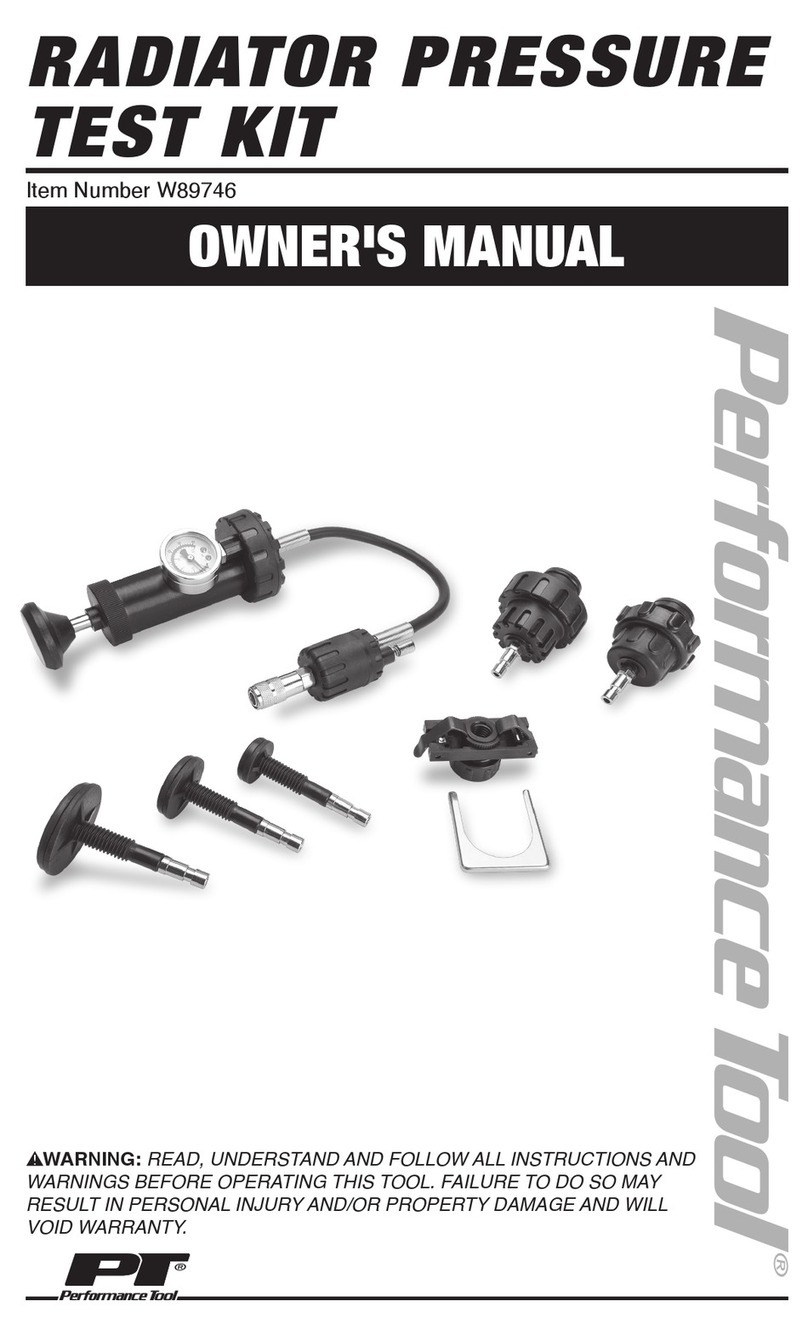
Performance Tool
Performance Tool W89746 owner's manual
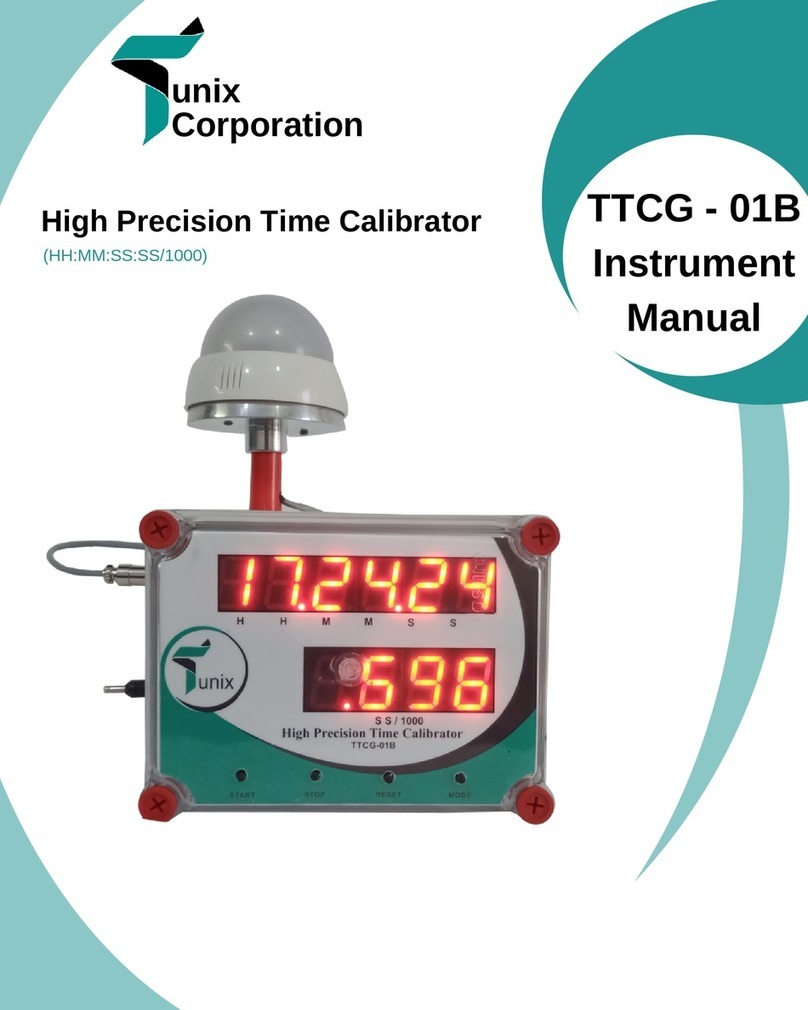
unix Corporation
unix Corporation TTCG - 01B Instrument manual
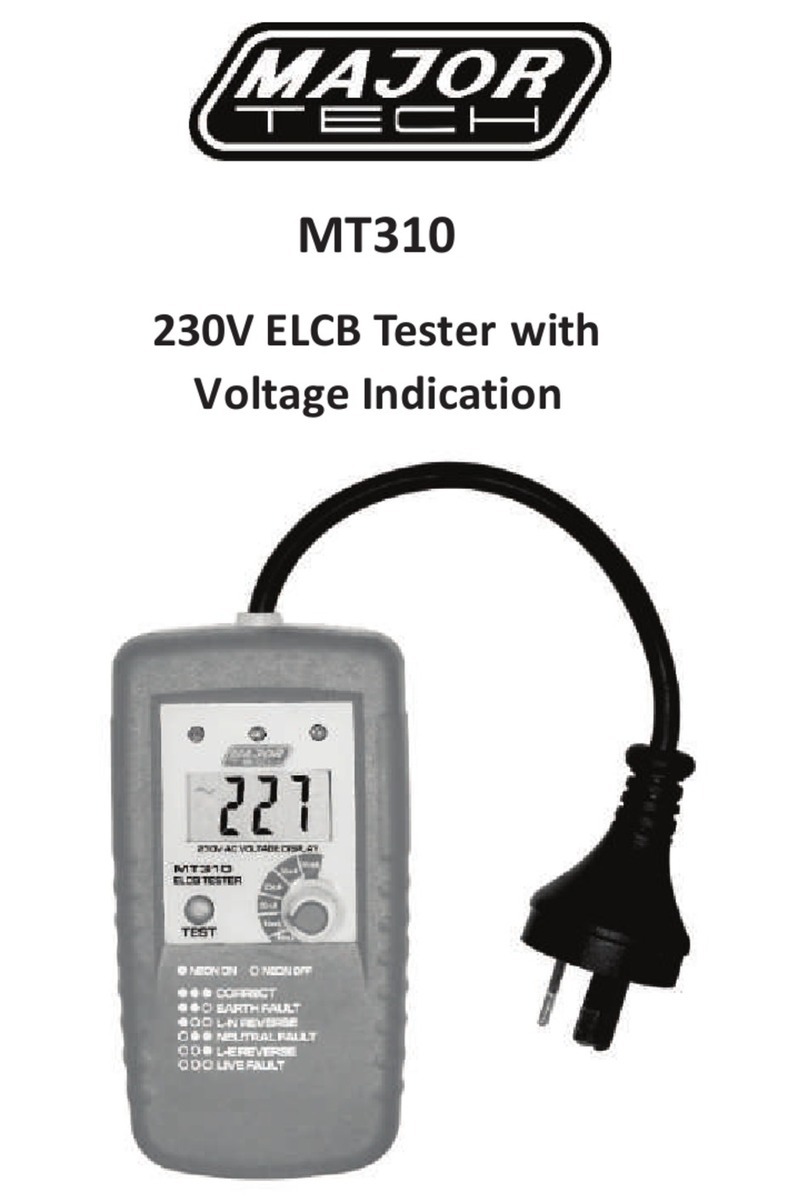
Major tech
Major tech MT310 instruction manual
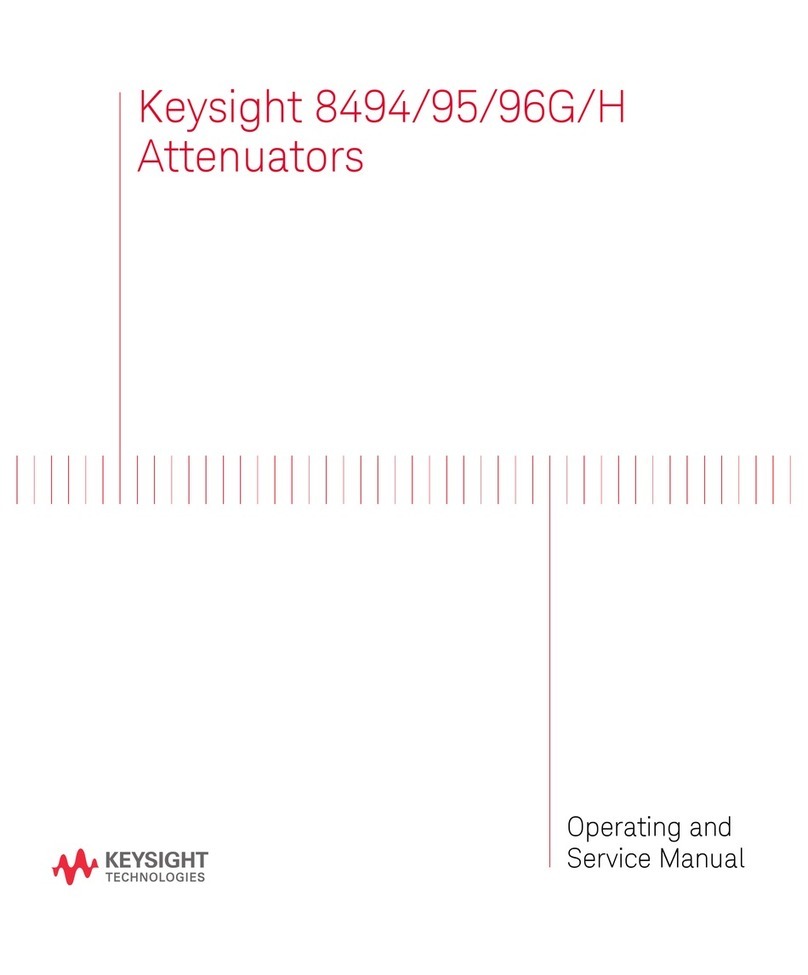
Keysight Technologies
Keysight Technologies 8494 Operating and service manual

Mastech
Mastech MS7222 operating instructions

Keysight Technologies
Keysight Technologies 16034E Operation and service manual
